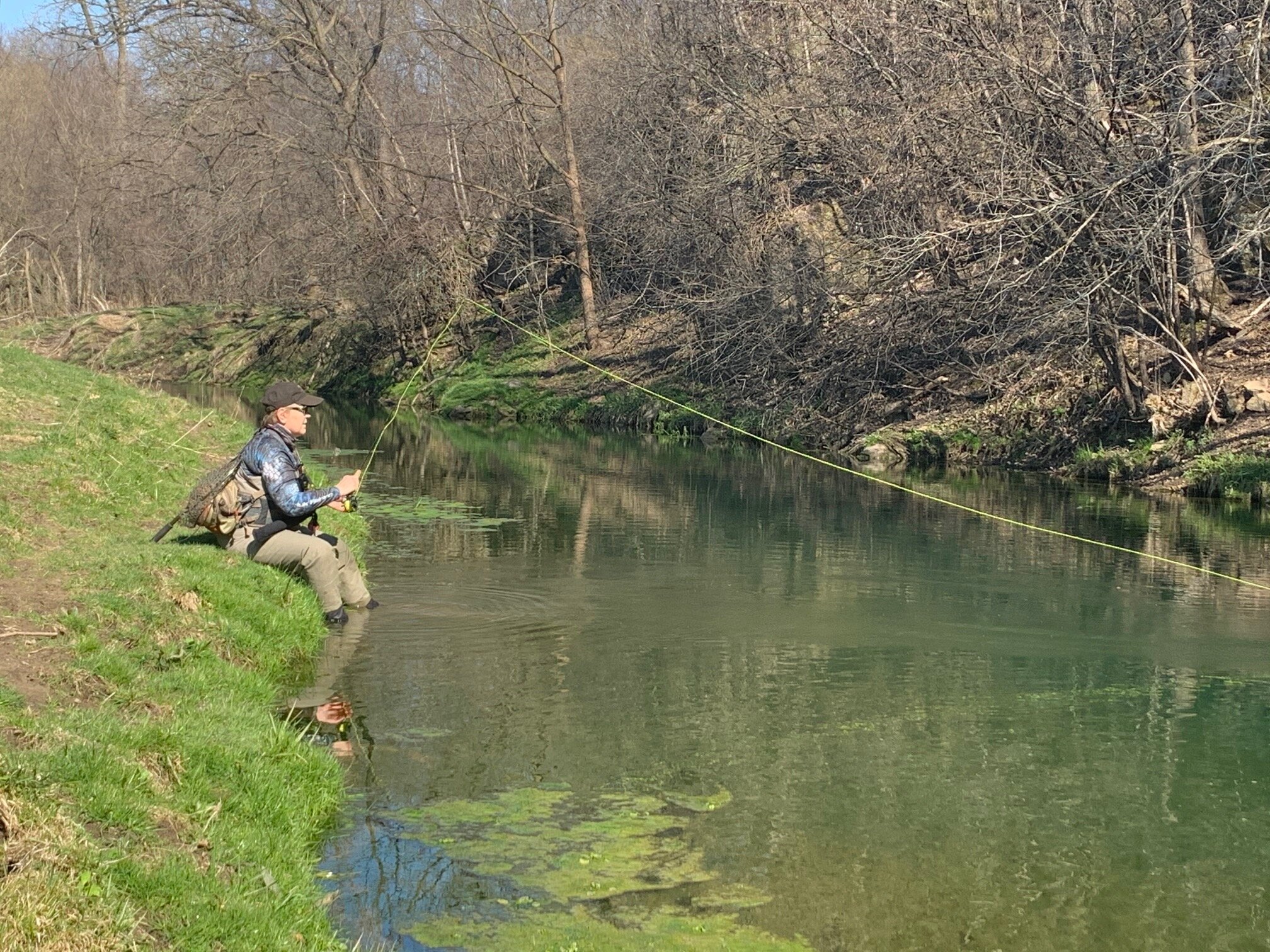This article is part of a larger series that investigates what we know about local tributaries around Lake Pepin. Follow us on Facebook and sign-up for our e-newsletter so you don’t miss the next release. If you have information or pictures for other Lake Pepin tributaries, please email us at: info@lakepepinlegacyalliance.org.
By: Emily Green
Fly fishing on Hay Creek (Photo Credit: Dan Traun)
Of the five Minnesota streams that drain directly into the Mississippi River Lake Pepin watershed (MRLP), Hay Creek is likely the best known. With its abundant brown trout population, one-hour proximity to the Twin Cities, and multiple easements creating easy public access [1], Hay attracts both local and metro-area anglers, who can easily stop by for an afternoon of casting.
Restoration efforts over the past several decades have bolstered both the quality of its fish habitat and its correlating popularity. Avid fisherman Justin Watkins (who also works as Southeast Watershed Unit Supervisor for the Minnesota Pollution Control Agency) described an idyllic spring day on Hay:
“It’s a really special time. You get all these wonderful insect hatches and the fish key in on those, eating those bugs while they're hatching. Then the adults [insects] are dying and falling back to the water, and the trout eat them up like candy bars . . . it’s kind of your romantic, traditional fly-fishing scene.”
Hay Creek flows through the northern part of the MRLP watershed and empties into the Mississippi just upstream of downtown Red Wing and the head of Lake Pepin. Predominantly spring-fed, with multiple small tributaries, Hay Creek has steady groundwater inputs ensure that it stays cold.
Trout fishing on Hay Creek (Credit: Dan Traun)
Hay Creek, 2020
Like the other MRLP streams, it was historically home to brook trout and other native aquatic species but became depopulated due to degradation stemming from farming practices in the late 19th and early 20th centuries. Investments in restoration and upstream soil conservation practices, combined with trout stocking (mostly browns) by the MN Department of Natural Resources (MN DNR) have led to its current state, which MN Department of Natural Resources (DNR) Area Fisheries Supervisor Kevin Stauffer characterized as “a top-level, coldwater trout stream.” [2]
According to Stauffer, the MN DNR started focusing on Hay’s restoration in the mid 1970s when the creek, like many Southeast MN streams, was in poor shape with substantial bank erosion, overwide channels, lack of depth, and a depleted fish community. At that time there was growing recognition that degraded streams could be restored, and trout fisheries revived, through a combination of stream-specific measures and conservation land management in the surrounding watershed. As Stauffer puts it:
“People started to understand that the watershed impact was a really big driver in these problems because of your overland delivery of sediment, your flooding events, and erosion. So there started to be a lot more effort to manage these watersheds and improve the stream that way, as opposed to just working right in the stream.”
In the early 2000s, MN Trout Unlimited (TU) began stepping up its efforts to restore fish habitat in selected streams within each of their six regional chapters. Tony Nelson, the habitat chairperson for the TU Twin Cities Chapter, said that the MN DNR recommended his chapter focus on Hay because of its accessibility for metro anglers, and because it was a good-sized creek with the potential for good ecological outcomes and for hosting a substantial trout population.
Since 2008, TU has played a leading role in channeling nearly $800,000 of public dollars via the Outdoor Heritage Fund--one of four funds created by Minnesota’s Clean Water, Land, and Legacy Amendment--toward restoring around five of Hay’s 18 stream miles, in six distinct projects.
Hay Creek erosion, 2020.
Restoring Hay has required removing accumulated silt from the streambed to expose the pebbly substrate that trout need for feeding and laying eggs. Some projects built rock weirs to narrow certain stretches and create the deeper water habitat zones that trout also require. All of the projects have included rebuilding or stabilizing banks to prevent stream “over-widening,” and limit erosion.
“Reducing erosion is huge for us,” declared Nelson. “Turbidity, meaning muddy water, is one of the biggest dangers to trout. So if we can bring that down, open up the bottom of the streams, that really helps improve the habitat.”
Planting riparian areas in perennial vegetation is another critical strategy for stopping erosion into streams. According to Nelson, TU restoration projects typically plant 12 acres of riparian prairie for every mile of stream restored, so they’ve likely restored around 60 prairie acres alongside Hay. Most of those acres replaced cropland, but in at least one case trees were removed to return a site to its historic natural state.
Jayden Jech “creeking” in Hay Creek during his LPLA internship, 2020
“Most of [Hay’s upland] landscape was historically prairie, so that’s the best thing to put in to keep this stream healthy. I’ve seen some [restored] stretches [on Hay] handle up to 10, 10 and a half-inch rainstorm and the banks held. The prairie grass just lays down, but its roots are deep, so they hold those banks in place. Then when the water goes back down, the grasses just stand back up,” said Nelson.
Stabilized banks and vegetated riparian areas have additional benefits. They help landowners reduce the likelihood of property damage from major rain events. Nelson explains how erosion mitigation protects property and the pocketbook:
“What we’re doing takes away a lot of the uncertainty for the landowner. They know the next big storm isn’t going to take out my barn, or flood my house. I heard a farmer tell me ‘I paid a lot of money for this land, so I like to keep it here.’ So if we can stabilize those banks so that farmers' land, that beautiful black dirt, isn’t just washing down. That's a very good thing for everyone.”
There’s no doubt that the extensive investments in restoration and conservation land management have improved Hay Creek over time. As of 2008, its turbidity levels still triggered the MN Pollution Control Agency (MPCA) to declare it impaired for aquatic life. But in 2014, the MPCA removed its impairment listing because the fish and invertebrate numbers had improved sufficiently. Nelson, who has personally fished Hay for 35 years, underscored the value of the restoration efforts for Hay’s fish community.
“It was a decent trout stream, many years ago, running about 1500 fish per mile. Now last I heard, they're running up to about 6500 per mile,” he said, adding “It’s by far the best trout stream in the Twin Cities chapter.”
More than just a great trout stream, Hay Creek is a valued natural resource for the local community, and its scenic value fueled the establishment of the DNR’s popular Goodhue Pioneer State Trail that parallels a stretch of Hay from Red Wing to the little town of Hay Creek.
The Red Wing Environmental Learning Center makes good use of Hay Creek in their educational programming for local youth, with long-standing programs such as trout fishing and stream ecology studies for high schoolers. Executive Director Jason Jech also described taking local 4th and 5th-grade students on “creeking” expeditions in which they walk alongside or in a stretch of Hay--with the goals of observing, getting to know the creek, and simply having fun. He says,
“We really don’t have a set agenda, we’re just exploring, and nobody knows what we’ll find or see until we get there. Sometimes we observe bank erosion and talk about what’s going on there. Usually we talk about how streams are always changing. It’s really just cool to see and listen to the kids as they’re poking around and giggling and laughing, doing something they don’t normally do. Often they’ll ask, ‘can I come back here?’ and I say “of course! It’s everybody’s stream’.
Indeed, Hay Creek’s accessibility makes it a boon for so many people. No doubt anglers throughout the area are already dreaming of next spring’s idyllic spring days on the creek.
Trout Fishing Hay Creek Highlights (Credit: Dan Traun)
[1] MN DNR easement maps, showing public fishing access to Hay Creek and other local trout streams.
[2] Like the other MRLP streams, in 2012 the MPCA declared Hay impaired for aquatic use due to elevated levels of E. coli. That impairment will recur in 2021. For more information about E. coli in SE Minnesota streams, see our Miller Creek blog post .
This article is part of a larger series that investigates what we know about eight Lake Pepin tributaries. Follow us on Facebook and sign-up for our e-newsletter so you don’t miss the next release. If you have information or pictures for other Lake Pepin tributaries, please email us at: info@lakepepinlegacyalliance.org.
Other articles in the series will be listed below as they are published:
Miller Creek: Water Protection Efforts Proceed In Miller Creek, Even As E. Coli Situation Baffles
Gilbert Creek: Now Proposed as Exceptional Water Body
Wells Creek: A Dynamic Stream With Many Trout, But Rising Sediment Concerns
Bullard Creek: Upland Water Storage Limits Erosion, but Sediment Still Impacts Wacouta Bay
Emily Green is a writer, editor, and researcher with particular interests in environmental protection, climate change, and environmental civic engagement. She has an M.S. degree in conservation biology from the University of Minnesota and a B.A. in English.





